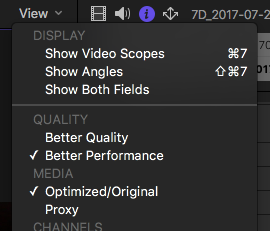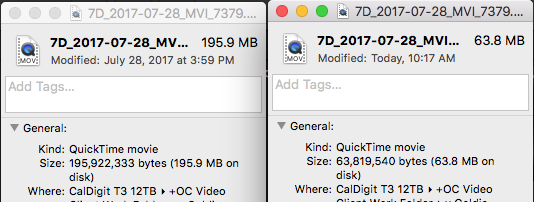I received an email today asking this:
I read a post you wrote back in 2013 and I can’t find anything on my question.
So I decided I want to use this to speed up my editing since it gets choppy on playback making it very hard to edit. I would like to know what is the difference in optimized and proxy? Why should I transcode to both or one of them? I have a feeling proxy is the best for quicker transcode and smaller file size. But why would you transcode to optimized or both? Thanks.
Thanks for asking. I’ll be happy to help clarify.
Optimized is a full resolution ProRes version of your clips, while Proxy is a quarter resolution ProRes Proxy version of your clips. The difference in size of the clips and data rate can make a significant difference in the smoothness of editing.
Optimized Media
As I said, Optimized is a full resolution ProRes version of your clips. Optimized is most useful when your computer for whatever reason, can’t decode a clip in full resolution fast enough to play back smoothly. On my system, I have trouble playing back some 1080 footage from a particular Sony camera, for whatever reason my FCPX system just doesn’t like it. I also have inexpensive stock footage that although encoded with h264, again just doesn’t play back well. Therefore, I optimize anytime I get this type of footage. Once I optimize it, it makes my editing smooth while still editing and exporting in full resolution. As long as my Media setting is on “Optimized/Original” that is (see image)

The only drawback with optimized is the storage bandwidth and space needed. Since optimized is standard ProRes 422, the data rate for 1080p material is 147 Mb/sec or about 20 megabytes per second. H264 on the other hand is in the 50 Mb/sec range or 6 Megabytes per second. If you have a 4 camera multicam, you’ve suddenly jumped from needing 12 megabytes per second of bandwidth to 80 megabytes per second. While this isn’t a problem if you have a decent RAID, if your editing on a spinning disk or over gigabit ethernet Optimized footage will quickly saturate it.
You can learn more about ProRes here:
https://images.apple.com/final-cut-pro/docs/Apple_ProRes_White_Paper.pdf
Proxy
Proxy is a quarter resolution ProRes Proxy version of your clips, and not only is the number of pixels reduced by 1/4 but because of the ProRes Proxy codec, the space needed and bandwidth is reduced by another 1/3. The result is that it takes 1/7 the bandwidth and size. This means that for for footage on a codec like Canon h264 1080p material, ProRes Proxy is even significantly smaller.

Canon 1080p h264 on the left, FCPX Proxy on the right.
Proxy also switches Final Cut Pro X into 1/4 resolution, so playback, rendering and sharing/export are all at 1/4 resolution. This is the big gotcha with Proxy as you need to be aware of it when exporting as it will render at 1/4 resolution, although it will still export at the pixel size chosen when you share. Personally I use Proxy when I’m working on multicam with more than 3 angles. Instead of struggling to playback, it just flies in Proxy. I also have some older iMacs that I reserve for assistant editors or sound cleanup and transcoding to proxy lowers the CPU usage for that older Mac and also lets us have multiple streams over our gigabit ethernet network.


